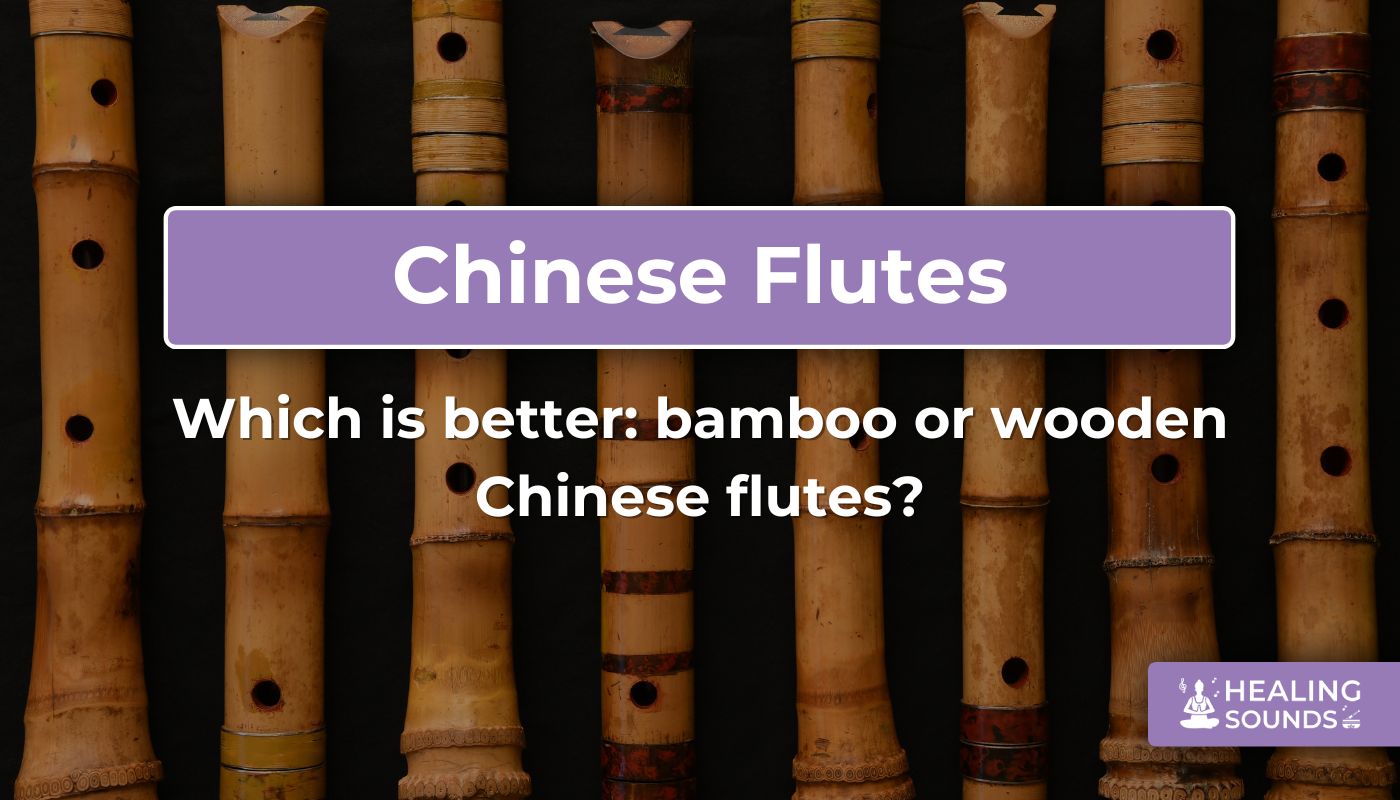Choisir entre flûtes chinoises en bambou et en bois est une question fréquente pour les musiciens et les passionnés attirés par les sonorités captivantes des instruments traditionnels chinois. Ces deux matériaux offrent des qualités sonores uniques et revêtent une profonde signification culturelle. Que vous soyez séduit par le son clair et perçant de la flûte Dizi ou par les sonorités douces et profondes souvent associées à la flûte Xiao , le choix du matériau influence considérablement la sonorité, le toucher et la longévité de l'instrument. Ce guide se penche sur les caractéristiques des flûtes en bambou et en bois, explorant leurs profils sonores, leur durabilité, leurs besoins d'entretien et leurs contextes culturels, afin de vous aider à choisir l'instrument idéal pour votre voyage musical.
Qu'est-ce qui définit les flûtes chinoises ? Le rôle du matériau
Les flûtes chinoises, telles que la flûte traversière Dizi et la flûte Xiao à embouchure terminale, sont des piliers de la musique traditionnelle chinoise. La Dizi est célèbre pour son trou recouvert d'une membrane (dimo), qui produit un timbre bourdonnant et brillant caractéristique. La Xiao, à l'inverse, évoque souvent une atmosphère plus sereine et mélancolique avec sa voix plus douce et plus profonde. Si la technique de jeu façonne la musique, le matériau – principalement le bambou ou divers bois – définit fondamentalement le potentiel sonore et le caractère de l'instrument.
Comprendre les propriétés intrinsèques du bambou et du bois est la première étape pour comprendre pourquoi l'un est préféré à l'autre. Explorons ce qui distingue chaque matériau dans l'univers des flûtes chinoises.
Le cas des flûtes en bambou : des tons vifs et une résistance naturelle
Le bambou est le matériau le plus traditionnel et le plus utilisé pour la fabrication des flûtes chinoises, notamment la flûte Dizi . Sa prédominance s'explique par ses excellentes propriétés acoustiques, son côté pratique et sa résonance culturelle.
Caractéristiques sonores : Vibrant et résonnant
Les flûtes en bambou sont réputées pour leur son clair, clair et résonnant. La structure naturelle du bambou, avec sa composition fibreuse et ses segments creux, se prête à la production d'harmoniques vibrantes. Cela confère aux flûtes en bambou, et notamment au dizi, une expressivité exceptionnelle et une excellente projection, même en groupe ou en extérieur. Le « bourdonnement » caractéristique du dizi, créé par la membrane dimo, est particulièrement prononcé sur les instruments en bambou.

Flûte dizi en bambou pour débutants, traditionnelle chinoise
23,90 € 28,00 €
Découvrez le son classique et brillant du bambou avec ce Dizi, parfait pour les débutants qui explorent la musique traditionnelle chinoise.
Explorez ce DiziAvantages pratiques : léger, durable et écologique
Au-delà du son, le bambou offre des avantages pratiques. Remarquablement léger par rapport à la plupart des bois, il est confortable à tenir et à jouer pendant de longues périodes. Malgré sa légèreté, le bambou mature est solide et relativement durable. Sa résistance naturelle aux variations d'humidité (comparativement au bois) le rend moins sujet aux fissures sous différents climats.
De plus, le bambou est une ressource hautement durable. C'est l'une des plantes à la croissance la plus rapide sur Terre, sa culture nécessitant peu de ressources. Choisir une flûte en bambou est souvent perçu comme un choix respectueux de l'environnement.
Entretien et soins du bambou
L'entretien d'une flûte en bambou est relativement simple. Un huilage occasionnel (avec des huiles spécifiques pour flûte ou de l'huile d'amande) peut prévenir le dessèchement et les fissures, surtout dans les environnements très secs. Il est recommandé d'essuyer l'intérieur après chaque utilisation. Un stockage approprié, à l'abri des températures extrêmes et de la lumière directe du soleil, garantit sa longévité.
Le charme des flûtes en bois : timbre profond et savoir-faire traditionnel
Bien que moins courant que le bambou pour les dizis, le bois est parfois utilisé. Il constitue un choix fréquent pour les flûtes Xiao de haute qualité ou les dizis spécialisés recherchant une tonalité différente. Divers bois durs comme le palissandre, le santal, l'ébène ou l'érable vieilli peuvent être utilisés.
Caractéristiques sonores : Riche, doux et concentré
Les flûtes chinoises en bois produisent généralement un son plus chaud, plus doux et souvent plus sombre que leurs homologues en bambou. La densité et la structure du bois ont tendance à absorber certaines fréquences plus aiguës, ce qui produit un son plus doux et plus riche. Ceci est particulièrement apprécié pour les mélodies introspectives de la flûte Xiao ou pour les musiciens recherchant moins de « bourdonnement » et plus de corps dans leur son Dizi. Le son est souvent décrit comme plus précis et complexe.
Considérations : poids, savoir-faire et esthétique
Les flûtes en bois sont généralement plus lourdes que celles en bambou. Le savoir-faire nécessaire à la fabrication d'une flûte en bois de qualité peut être plus complexe, ce qui se traduit souvent par un prix plus élevé. Les bois durs permettent une sculpture et une finition soignées, donnant naissance à des instruments souvent esthétiques, mettant en valeur la beauté naturelle du grain du bois. Ces instruments sont parfois prisés des musiciens professionnels et des collectionneurs.
Entretien et soins du bois
Les flûtes en bois nécessitent un entretien minutieux. Elles sont plus sensibles aux variations de température et d'humidité, ce qui augmente le risque de fissures en cas de mauvais entretien. Un nettoyage régulier (élimination de l'humidité après chaque utilisation) est essentiel. Un huilage régulier de la perce (avec une huile adaptée) contribue à protéger le bois. Une adaptation minutieuse à un nouvel environnement est également essentielle.
Comparaison des facteurs clés : bambou et bois
Comparons directement les flûtes chinoises en bambou et en bois sur des aspects cruciaux :
| Fonctionnalité | Flûtes en bambou | Flûtes en bois |
|---|---|---|
| Qualité sonore | Des harmoniques lumineuses, claires, résonnantes et vibrantes (en particulier Dizi) | Ton chaud, doux, sombre, riche et concentré |
| Durabilité | Bonne durabilité naturelle, moins sujet aux fissures dues à l'humidité | Peut être très durable (bois durs), mais plus sensible aux changements d'humidité/température |
| Jouabilité et maniabilité | Léger, confortable à tenir | Plus lourd, peut nécessiter plus de réglages |
| Coût et valeur | Généralement plus abordable, excellent rapport qualité/prix pour les débutants/intermédiaires | Généralement plus cher en raison du coût des matériaux et de l'artisanat |
| Entretien | Entretien relativement faible, graissage occasionnel | Nécessite un nettoyage et un huilage minutieux, ainsi qu'un contrôle minutieux de l'humidité |
| Impact environnemental | Ressource hautement durable | Cela dépend de la source du bois (les pratiques de foresterie durable varient) |
| Utilisation traditionnelle | Le plus courant pour Dizi, largement utilisé pour Xiao | Utilisé pour les Xiao haut de gamme, certains Dizi spécialisés et les variantes historiques |
Quelle flûte convient à votre parcours musical ?
Le choix entre une flûte en bambou et une flûte en bois dépend fortement de vos objectifs et préférences personnels.
Pour les débutants et les passionnés de folk
Si vous débutez avec les flûtes chinoises ou si vous vous intéressez principalement aux styles de musique folklorique, une flûte dizi ou xiao en bambou est souvent le choix recommandé. Elles offrent un son caractéristique, sont plus faciles d'entretien, plus abordables et capturent efficacement l'essence traditionnelle.
Pour les joueurs de musique classique et les collectionneurs
Les musiciens se concentrant sur le répertoire classique, recherchant des nuances tonales spécifiques, ou les collectionneurs appréciant l'artisanat et l'esthétique pourraient se tourner vers une flûte en bois de haute qualité (en particulier Xiao) ou un instrument en bambou de qualité professionnelle fabriqué à partir de bambou sélectionné et vieilli.
Pour les pratiques de méditation et de guérison
Les sonorités apaisantes et aérodynamiques de la flûte Xiao sont fréquemment utilisées en méditation et en sonothérapie. Bien que les deux matériaux soient efficaces, la sensation naturelle et les sonorités parfois plus douces d'une flûte Xiao en bambou de qualité supérieure conviennent parfaitement à ces pratiques. Découvrez des instruments dédiés à la relaxation.
- Écoutez des enregistrements de flûtes en bambou et en bois (Dizi et Xiao) pour identifier les profils sonores que vous préférez.
- Tenez compte de votre budget et de votre engagement envers l’entretien des instruments.
- Pensez au style de musique principal que vous souhaitez jouer.
- Si possible, essayez de tenir les deux types pour ressentir la différence de poids et d’équilibre.
Découvrez notre collection de flûtes chinoises en bambou

44,90 €
52,00 €
Fabriqué en bambou vieilli, ce dizi offre un son et une expérience de jeu traditionnels raffinés. En savoir plus ➔

39,99 €
59,99 €
Découvrez les sons paisibles et doux propices à la méditation avec cette flûte Xiao traditionnelle en bambou . En savoir plus ➔

26,90 €
29,90 €
Choisissez votre tonalité préférée (Do, Ré, Mi, Fa, Sol) avec cette flûte Dizi en bambou polyvalente et abordable, idéale pour accompagner différents morceaux. En savoir plus ➔
Conclusion : trouver votre son
En fin de compte, le choix entre flûtes chinoises en bambou et en bois est subjectif. Le bambou offre brillance, praticité, durabilité et prix abordable, ce qui en fait la référence et un excellent choix pour beaucoup. Le bois offre chaleur, profondeur, beauté esthétique et une expérience tactile différente, attirant ceux qui recherchent des couleurs tonales spécifiques ou apprécient un savoir-faire artisanal. Tenez compte du son que vous recherchez, de votre budget et de votre contexte de jeu. Explorez le riche univers des flûtes chinoises, comme le Dizi et son histoire fascinante , et trouvez l'instrument qui résonne véritablement avec votre âme musicale. Healing Sounds propose une sélection soignée de flûtes en bambou de haute qualité pour débuter ou poursuivre votre exploration.
Questions fréquemment posées sur les flûtes chinoises en bambou et en bois
Aucune des deux n'est définitivement « meilleure » ; tout dépend des préférences. Les flûtes en bambou sont généralement plus brillantes, plus légères, plus résistantes à l'humidité, durables et abordables (idéales pour les débutants et les musiciens folkloriques). Les flûtes en bois offrent des sonorités plus chaudes et plus douces, souvent plus esthétiques et plus travaillées, mais sont plus lourdes, plus coûteuses et nécessitent un entretien plus soigné.
Les types les plus courants sont la flûte dizi (transversale, avec une membrane pour un timbre bourdonnant) et la flûte xiao (à soufflet transversal, connue pour ses sonorités plus douces et plus veloutées). Il existe des variantes au sein de ces catégories, comme la bangdi (dizi plus courte), la qudi (dizi plus longue), et différentes tonalités et styles régionaux pour ces deux types de flûte.
Oui, le bambou est un excellent matériau pour les flûtes, en particulier les flûtes traditionnelles chinoises . Ses propriétés acoustiques naturelles produisent des sons clairs et résonnants. Il est également léger, relativement résistant, durable et abordable, ce qui en fait le choix le plus populaire pour des instruments comme le dizi et le xiao.
Pour un son et un toucher traditionnels, le bambou est généralement considéré comme supérieur au PVC. Il offre des qualités sonores plus riches et une résonance naturelle. Les flûtes en PVC sont très durables et résistantes aux intempéries, souvent utilisées pour la pratique ou dans des conditions difficiles, mais elles n'ont pas la complexité acoustique ni le caractère traditionnel d'une flûte en bambou .
Les principales différences sont : le son (bambou = plus brillant, résonnant ; bois = plus chaud, plus doux), le poids (bambou plus léger), la durabilité (le bambou est plus résistant aux fissures dues à l'humidité, la densité du bois varie), l'entretien (le bois nécessite plus de soins), le coût (le bambou est généralement moins cher) et la durabilité (le bambou pousse plus vite).

